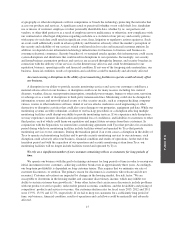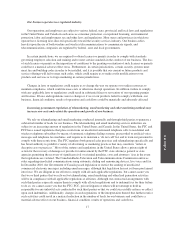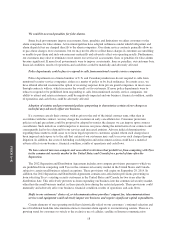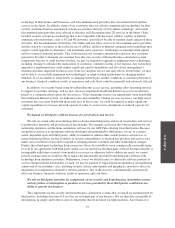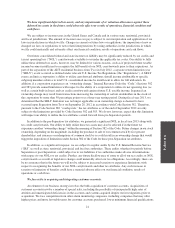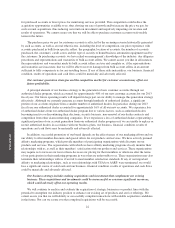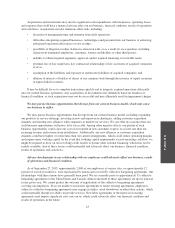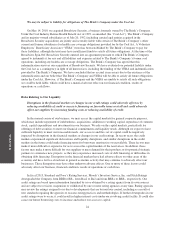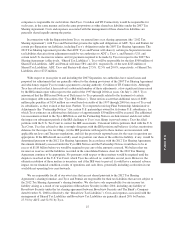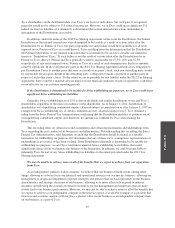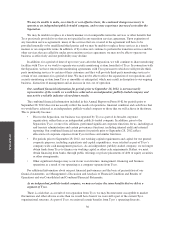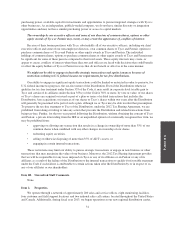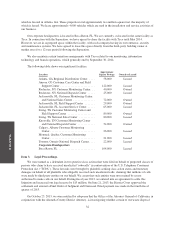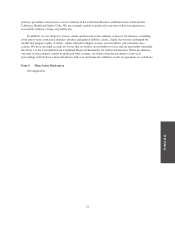ADT 2013 Annual Report Download - page 87
Download and view the complete annual report
Please find page 87 of the 2013 ADT annual report below. You can navigate through the pages in the report by either clicking on the pages listed below, or by using the keyword search tool below to find specific information within the annual report.
FORM 10-K
Acquisitions and investments may involve significant cash expenditures, debt incurrence, operating losses
and expenses that could have a material adverse effect on our business, financial condition, results of operations
and cash flows. Acquisitions involve numerous other risks, including:
• diversion of management time and attention from daily operations;
• difficulties integrating acquired businesses, technologies and personnel into our business or achieving
anticipated operations efficiencies or cost savings;
• possibility of litigation or other claims in connection with, or as a result of, an acquisition, including
claims from terminated employees, customers, former stockholders or other third parties;
• inability to obtain required regulatory approvals and/or required financing on favorable terms;
• potential loss of key employees, key contractual relationships or key customers of acquired companies
or of us;
• assumption of the liabilities and exposure to unforeseen liabilities of acquired companies; and
• dilution of interests of holders of shares of our common stock through the issuance of equity securities
or equity-linked securities.
It may be difficult for us to complete transactions quickly and to integrate acquired operations efficiently
into our current business operations. Any acquisitions or investments may ultimately harm our business or
financial condition, as such acquisitions may not be successful and may ultimately result in impairment charges.
We may pursue business opportunities that diverge from our current business model, which may cause
our business to suffer.
We may pursue business opportunities that diverge from our current business model, including expanding
our products or service offerings, investing in new and unproven technologies, adding customer acquisition
channels and forming new alliances with companies to market our services. We can offer no assurance that any
such business opportunities will prove to be successful. Among other negative effects, our pursuit of such
business opportunities could cause our cost of investment in new customers to grow at a faster rate than our
recurring revenue and revenue from installations. Additionally, any new alliances or customer acquisition
channels could have higher cost structures than our current arrangements, which could reduce operating margins
and require more working capital. In the event that working capital requirements exceed operating cash flow, we
might be required to draw on our revolving credit facility or pursue other external financing, which may not be
readily available. Any of these factors could materially and adversely affect our business, financial condition,
results of operations and cash flows.
Adverse developments in our relationship with our employees could adversely affect our business, results
of operations and financial condition.
As of September 27, 2013, approximately 2,000 of our employees at various sites, or approximately 12
percent of our total workforce, were represented by unions and covered by collective bargaining agreements. Our
relationships with these unions have generally been good. We are currently party to approximately 35 collective
bargaining agreements in the United States and Canada. Almost one-third of these agreements are up for renewal
in any given year. We cannot predict the outcome of negotiations of the collective bargaining agreements
covering our employees. If we are unable to reach new agreements or renew existing agreements, employees
subject to collective bargaining agreements may engage in strikes, work slowdowns or other labor actions, which
could materially disrupt our ability to provide services. New labor agreements or the renewal of existing
agreements may impose significant new costs on us, which could adversely affect our financial condition and
results of operations in the future.
23




